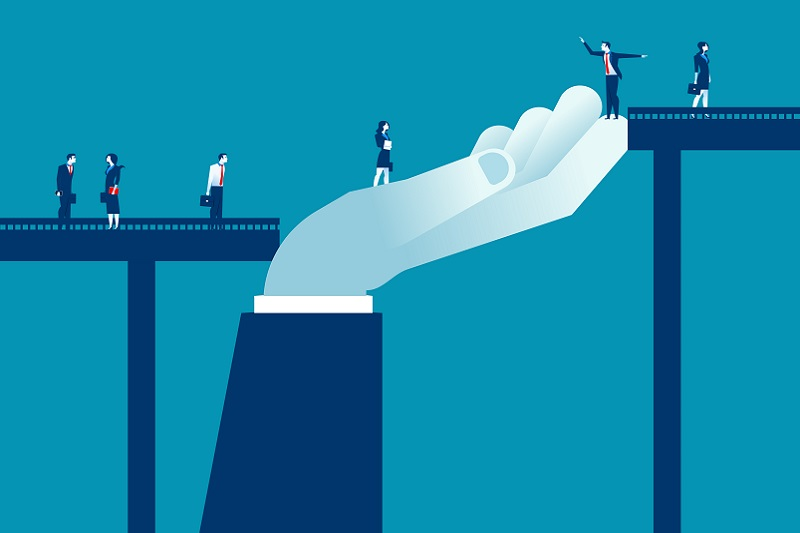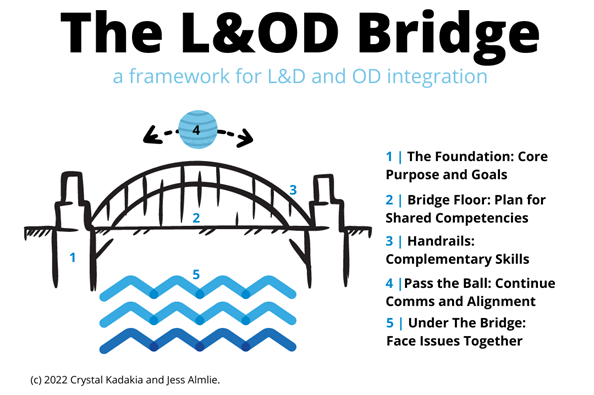ATD Blog
The L&OD Bridge Framework: The Ball and the Chasm
Fri Sep 30 2022

Over the past three blogs, we have explored what might be possible if learning and development (L&D) and organization development (OD) stop working in silos and start working together instead. We have shared steps in the L&OD Bridge Framework, a draft model we have been defining to help draw from the expertise of both fields to solve business problems.
We completed our prework to the build by exploring the differences in each field’s origin story as insight into our diverse thought patterns. We laid the bridge foundation by defining the core purpose based on business pain (Step 1) and then continued by creating the floor of the bridge with a plan to use our shared skills and competencies (Step 2). Last week, we built the handrails using the unique and complementary strengths of each field (Step 3). This week, we will complete our five-step bridge by defining what is both above and below the structure.

Step 4. Pass the Ball Across the Bridge Using Continuous Alignment and Communication
In steps 1–3, we created the bridge structure, but this isn’t enough to complete our framework. Now, we need to think about what it looks like to walk on the bridge over time. We need to ensure that it will remain a platform to improve cohesion and to not divide us back into silos. This is when we add the ball of communication and alignment to our process.
This ball continuously moves back and forth across the bridge, ensuring success for any collaborative process. If OD and L&D are indeed separate departments collaborating on a shared project, the ball often looks like regular collaborative working meetings and an agreed upon cadence for communications to stay updated. But if L&D in a smaller organization is working to adopt an OD mindset, the vision of the ball helps to keep both OD and L&D perspectives in mind as a project progresses.
In your plans, do you have working norms established regarding communication and progress check-ins? You don’t want your plan to be to “wait for a problem, and then we will rally the troops.” It’s better to be proactive and have an open, transparent space already established to consider adjustments that will benefit the business along the way.
Step 5. Identify the Chasm Under the Bridge: Address Our Shared Problems Together
Earlier in steps 1 and 2, we defined a core purpose as well as both shared and complementary strengths. But there are also challenges that both L&D and OD face in our respective professions. Both fields share an overall weakness when it comes to:
Evaluating Impact and Demonstrating ROI: This is, in part, because we are attempting to measure intangible results (like behavior change). It can also be difficult to show direct correlation between the intervention and result.
Getting Funding and Staffing: L&D and OD often compete for resources with more tactical business functions. Both fields are generally seen as a cost center rather than a revenue producer. The lack of solid data and meaningful correlation between work and revenue make it difficult to justify headcount and investment.
Providing Short-Lived Impact: Both fields are guilty of creating solutions in the form of one-and-done events. From diversity, equity, and inclusion (DEI) initiatives to culture change or leadership training, our interventions all too often are short-lived, especially with our limited capacity and the reality of continuous business change.
What do we do? In this step of the framework, we call out these weaknesses and put our heads together to address and work through the issues and challenges. Simply by working together, we are in a better place than where we started. We are no longer competing for impact but combining our results into the bigger picture.
By explicitly surfacing and addressing our shared problems together, our bridge will grow stronger from the center outwards, increasing our collective impact.
Building a Bridge by Working Together
The collaborative L&OD Bridge Framework becomes clear when we consider the five steps as a dynamic plan for working together. What if, when a new project starts, you and your colleagues visualize this bridge framework? Might the steps help establish a collaborative strategy? Rather than working as isolated or competitive forces in the organization, let’s get together behind our mutual goal of unleashing human potential in organizations. When we create a common purpose, use models that bring together our shared strengths, align continuously, and solve our common challenges together, we just might learn that by working together, the complexity of our businesses can be solved more effectively, and our stakeholders will benefit from the difference.
You've Reached ATD Member-only Content
Become an ATD member to continue
Already a member?Sign In
